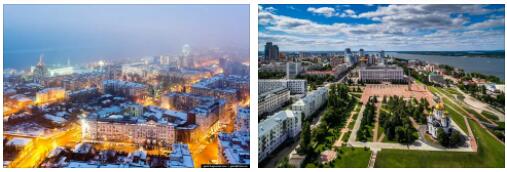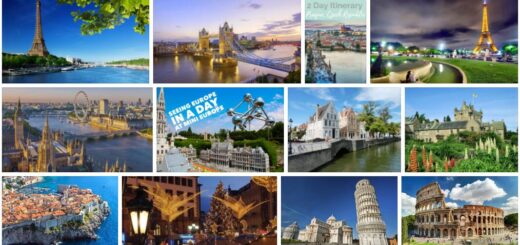Samara, Russia
According to cancermatters, Samara is located in the Middle Volga region on the left bank of the Volga River at the confluence of the Samara River. It is one of the largest industrial, cultural and scientific centers in Russia.
The first mention in historical documents of these places dates back to 1357. In that year, Metropolitan of Moscow and All Russia, Saint Alexy, on a trip to the Golden Horde, stopped for the night at the Samara tract, where he predicted the foundation of the city. In 1361, a small settlement-pier was founded here. The official date of foundation of the city is considered to be 1586, when the fortress – Samara town – began to be laid. The fortress was built as an outpost to protect the Russian borders from nomadic raids and as a customs house on the river route from Kazan to Astrakhan. During the Time of Troubles, the Samara town was the only Russian fortress in the southeast that remained intact. Therefore, he played a particularly important role. In 1688 the fortress received the status of a city. By that time, it had already become an important trading center through which trade was carried out with the East and the southern regions of the state. At the beginning of the 18th century, the eastern borders of the state expanded, the construction of a fortress in Orenburg began, so the Samara fortress lost its defensive significance.
In 1851 Samara becomes a provincial city. The second half of the 19th century was characterized by stormy trade – three major fairs were held annually in this region: Cathedral, Kazan and Vozdvizhenskaya, in addition, in 1877, the Orenburg railway was laid through Samara, the appearance of which contributed to the development of industry. In 1935, Samara was renamed Kuibyshev in honor of the statesman Valeryan Vladimirovich Kuibyshev. During the Great Patriotic War, Kuibyshev became the second capital of the Soviet Union. In 1941, government agencies, part of the military departments, as well as most industrial enterprises were evacuated here. Residents of the city worked for defense production in order to provide the army with military equipment. In 1991, the city was returned to its historical name – Samara. Nowadays Samara is the center of the Samara region and one of the largest cities in the Middle Volga region.
The historical city center (old city) is located at the confluence of the Volga and Samara rivers. Many architectural monuments of the 19th century have been preserved here. Buildings of more ancient times, unfortunately, were lost. The main square of the city is Kuibyshev Square. This is the largest square in Europe and the fifth largest in the world (174 thousand square meters). Until 1935, the square was called the Cathedral Square, since the Resurrection Cathedral in the name of Christ the Savior stood here. The temple was destroyed and the Palace of Culture appeared in its place. Also in 1938, a monument to Valeryan Vladimirovich Kuibyshev was erected here.
From the square begins the oldest street of the city – Kuibyshev Street. It leads to Chapaev Square. In the center of the square stands a monument to Vasily Ivanovich Chapaev. This multi-figured monument was erected in 1932. Also on the square you can see the building of the Samara Academic Drama Theater named after M. Gorky. The Drama Theater is one of the oldest in Russia, it was built in 1888 in the Moscow baroque style. At various times, his troupe included honored artists of the country. Behind the theater building there is a small square of A.S. Pushkin, in which a bust of the great Russian poet is installed.
Next to the theater is Stalin’s secret bunker, which was built in 1942 specifically for Joseph Vissarionovich Stalin at a depth of 37 m, when the government bodies of the USSR were evacuated to Samara. Stalin never visited here; today the museum is housed in the bunker. The museum was opened to the public in 1991. Here is an exposition about the course of the Great Patriotic War and about the stay of government organizations in the city. Nearby is the Military History Museum of the Volga Military District. The museum tells about the history of the Volga Military District, the Civil War, the Great Patriotic War and modern military events.
Behind Chapaev Square lies the largest park in the city – Gorky Central Park of Culture and Leisure.. If you go from Chapaev Square along Kuibyshev Street down to the Samara River to the southern part of the old city, you can see the mansions of A.N. Naumov and I.A. Klodt of the late 19th century, the Klodt mansion now houses the municipal museum “Children’s Picture Gallery”, the Lutheran Church of St. George of the second half of the 19th century, built in the Gothic style, which now belongs to the Evangelical Lutheran community, and the Samara Regional Art Museum. The Art Museum consists of several departments – the department of Russian and foreign art, which presents iconography, Russian painting, Russian avant-garde, Western European art of the 17th-19th centuries and the art of the East countries of the 15th-20th centuries, the department of modern art, where you can see the works of Soviet masters, the department “The Artistic Culture of Old Samara” with a collection of works by Samara artists – and two sectors dedicated to the life and work of several Samara artists – the sector “Museum-workshop of V. Z. Purygin” and the sector “Museum-apartment of Vasiliev artists”. There is also Revolution Square on Kuibyshev Street. In the center of the square stands a monument to Vladimir Ilyich Lenin. It was erected in 1927 on the pedestal of the destroyed monument to Alexander II. Kuibyshev Street runs into Khlebnaya Square. This place is notable for the fact that it was here that the Samara town was erected at the end of the 16th century. Today, the fortress is only reminiscent of a wooden log house installed at the end of the 20th century, imitating one of its towers. A little to the east along the banks of the Samara River is the River Station. Frunze Street runs parallel to Kuibyshev Street. It also has many attractions. The outstanding military leader M.V. Frunze lived and worked in the house-museum of M.V. Frunze for several years. He significantly influenced the culture of the city. House-Museum of Kurlina is located in the former mansion of the merchant Kurlina, which was built in 1900 and is now an excellent example of an Art Nouveau estate. An exposition on the history of the region from the time of the foundation of the Samara town (1586) to 1918 is inscribed in the interior of Kurlina’s house. This museum is under the jurisdiction of the Samara Regional Museum of History and Local Lore named after P.V. Alabina. A little to the north is the museum-estate of A.N. Tolstoy. Previously, the estate belonged to the writer’s parents. Museum expositions tell about the life and work of A.N. Tolstoy, his letters and photographs are kept here. Even from afar, the long spiers of the Roman Catholic Church of the Sacred Heart of Jesus are visible. The church was built in 1906 and has a height of 47 m. Frunze Street ends at the square of A.S. Pushkin.



